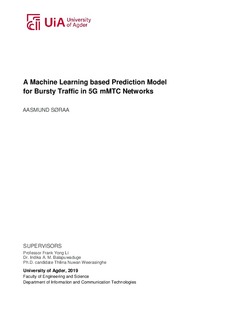| dc.description.abstract | The rapid growth in popularity for the Internet of Things (IoT) has paved the way for a newtype of communication, called Machine-type Communication (MTC), causing substantially in-creased traffic volume. The existing network infrastructure is facing challenges when handlingthe increased traffic load, especially under bursty conditions. Consequently, the network willmore often experience congestion during bursty conditions, which will in turn reduce through-put, and lead to a decline in quality of service.Several improvements have been studied to help support the increasing mMTC traffic load.However, most of these improvements are reactive, meaning that they are only enabled whencongestion is detected at the eNB. By predicting the occurrence of congestion in advance, wecan proactively implement the prediction based improvements and conceivably avoid conges-tion all together.In this thesis, we propose a machine learning (ML) based framework for forecasting traf-fic arrival, and subsequently predict the occurrence of congestion in bursty traffic conditions.The framework is composed of two ML algorithms, each responsible for a specific task. Thefirst algorithm is based on a long short-term memory (LSTM) architecture, a common type ofrecurrent neural network (RNN) suitable for modeling long-term time-series data. The secondalgorithm is based on a neural network used to classify whether or not the traffic is leading tocongestion. We test our solutions in various scenarios with additional sub-cases under differentnetwork conditions. In our tests we look at how the information available at the eNB affectstraffic forecasting, and how this in turn affects the congestion prediction.Our proposed framework achieves precise results in forecasting traffic arrival for certaintraffic conditions. We observe that for predicting congestion in the bursty window, the alreadyavailable data performs equally well or better than the forecasted data in all cases. With the orig-inal detected traffic, we achieve 100% accuracy on predicting congestion using the proposedclassification model. By implementing ML techniques at the eNB, we can reduce congestionand improve throughput in the network. | nb_NO |

